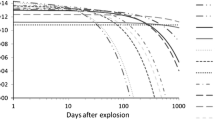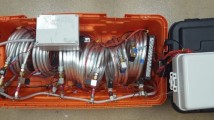Abstract
The International Monitoring System includes a network of radionuclide detectors operated around the world monitoring for nuclear explosions. A key aspect of the International Monitoring System is the verification of the results from the stations. The verification comes through calibration of the systems, and additional validation measurements from certified laboratories. In support of the Preparatory Commission of the Comprehensive Nuclear-Test-Ban Treaty Organization, there are 16 radionuclide laboratories around the world (with a subset of those laboratories having radioxenon measurement capabilities). We have developed a laboratory system for processing and measuring the radioxenon archive samples from the International Monitoring System. In this paper we describe the design and operation of the laboratory in support of verification of the Comprehensive Nuclear-Test-Ban Treaty.










Similar content being viewed by others
References
Auer, M., Axelsson, A., Blanchard, X., Bowyer, T., Brachet, G., Bulowski, I., et al. (2004). Intercomparison experiments of systems for the measurement of xenon radionuclides in the atmosphere. Applied Radiation and Isotopes, 60(6), 863–877. https://doi.org/10.1016/j.apradiso.2004.01.011.
Bläckberg, L., Fritioff, T., Mårtensson, L., Nielsen, F., Ringbom, A., Sjöstrand, H., et al. (2013). Memory effect, resolution, and efficiency measurements of an Al2O3 coated plastic scintillator used for radioxenon detection. Nuclear Instruments and Methods in Physics Research Section A: Accelerators, Spectrometers, Detectors and Associated Equipment, 714, 128–135. https://doi.org/10.1016/j.nima.2013.02.045.
Bowyer, T. W., Abel, K. H., Hubbard, C. W., McKinnon, A. D., Panisko, M. E., Perkins, R. W., et al. (1998). Automated separation and measurement of radioxenon for the Comprehensive Test Ban Treaty. Journal of Radioanalytical and Nuclear Chemistry, 235(1–2), 77–82. https://doi.org/10.1007/BF02385941.
Bowyer, T. W., Schlosser, C., Abel, K. H., Auer, M., Hayes, J. C., Heimbigner, T. R., et al. (2002). Detection and analysis of xenon isotopes for the comprehensive nuclear-test-ban treaty international monitoring system. Journal of Environmental Radioactivity, 59(2), 139–151. https://doi.org/10.1016/S0265-931X(01)00042-X.
Cagniant, A., Topin, S., Le Petit, G., Gross, P., Delaune, O., Philippe, T., et al. (2018). SPALAX NG: a breakthrough in radioxenon field measurement. Applied Radiation and Isotopes, 134, 461–465. https://doi.org/10.1016/j.apradiso.2017.06.042.
Cooper, M. W., Auer, M., Bowyer, T. W., Casey, L. A., Elmgren, K., Ely, J. H., et al. (2019). Radioxenon net count calculations revisited. Journal of Radioanalytical and Nuclear Chemistry, 321(2), 369–382. https://doi.org/10.1007/s10967-019-06565-y.
Cooper, M. W., Ely, J. H., Haas, D. A., Hayes, J. C., McIntyre, J. I., Lidey, L. S., et al. (2013). Absolute efficiency calibration of a beta-gamma detector. IEEE Transactions on Nuclear Science, 60(2), 676–680. https://doi.org/10.1109/TNS.2013.2243165.
Currie, L. A. (1968). Limits for qualitative detection and quantitative determination. Application to radiochemistry. Analytical Chemistry, 40(3), 586–593. https://doi.org/10.1021/ac60259a007.
Foltz Biegalski, K. M., & Biegalski, S. R. (2001). Determining detection limits and minimum detectable concentrations for noble gas detectors utilizing beta-gamma coincidence systems. Journal of Radioanalytical and Nuclear Chemistry, 248(3), 673–682. https://doi.org/10.1023/A:1010684410475.
Foxe, M.P., Miller, B.W., Suarez, R., & Hayes, J.C. (2015). A Figure-of-Merit for Beta Cell Detector Characterization (No. PNNL-24760). https://doi.org/10.2172/1258732
Galan, M., Kalinowski, M., Gheddou, A., & Yamba, K. (2018). New evaluated radioxenon decay data and its implications in nuclear explosion monitoring. Journal of Environmental Radioactivity, 192, 628–634. https://doi.org/10.1016/j.jenvrad.2018.02.015.
Gohla, H., Auer, M., Cassette, P., Hague, R. K., Lechermann, M., & Nadalut, B. (2016). Radioxenon standards used in laboratory inter-comparisons. Applied Radiation and Isotopes, 109, 24–29. https://doi.org/10.1016/j.apradiso.2015.11.044.
Haas, D. A., Eslinger, P. W., Bowyer, T. W., Cameron, I. M., Hayes, J. C., Lowrey, J. D., et al. (2017). Improved performance comparisons of radioxenon systems for low level releases in nuclear explosion monitoring. Journal of Environmental Radioactivity, 178–179, 127–135. https://doi.org/10.1016/j.jenvrad.2017.08.005.
Harper, W.W., Schrom, B.T. (2013). The MKS-910 Concentration Lookup Library (No. PNNL-25671). Richland, WA (United States).
Kebeasy, R. (2008). The CTBTO international monitoring system and global seismicity. In E. S. Husebye (Ed.), Earthquake monitoring and seismic hazard mitigation in Balkan Countries (pp. 113–120). Dordrecht: Springer Netherlands.
Mcintyre, J. I., Abel, K. H., Bowyer, T. W., Hayes, J. C., Heimbigner, T. R., Panisko, M. E., et al. (2001). Measurements of ambient radioxenon levels using the automated radioxenon sampler/analyzer (ARSA). Journal of Radioanalytical and Nuclear Chemistry, 248(3), 629–635. https://doi.org/10.1023/A:1010672107749.
Miley, H. S., Bowyer, S. M., Hubbard, C. W., McKinnon, A. D., Perkins, R. W., Thompson, R. C., et al. (1998). Automated aerosol sampling and analysis for the comprehensive test ban treaty. IEEE Transactions on Nuclear Science, 45(3 PART 1), 1034–1039. https://doi.org/10.1109/23.682702.
Pritychenko, B., Sonzogni, A. A., Winchell, D. F., Zerkin, V. V., Arcilla, R., Burrows, T. W., et al. (2006). Nuclear reaction and structure data services of the national nuclear data center. Annals of Nuclear Energy, 33(4), 390–399. https://doi.org/10.1016/j.anucene.2005.10.004.
Reeder, P. L., Bowyer, T. W., McIntyre, J. I., & Pitts, W. K. (2001). Determination of 131mXe and 133mXe in the presence of 133gXe via combined beta-spectroscopy and delayed coincidence. Journal of Radioanalytical and Nuclear Chemistry, 248(3), 617–622. https://doi.org/10.1023/A:1010668006840.
Reeder, P. L., Bowyer, T. W., & Perkins, R. W. (1998). Beta-gamma counting system for Xe fission products. Journal of Radioanalytical and Nuclear Chemistry, 235(1–2), 89–94. https://doi.org/10.1007/BF02385943.
Ringbom, A., Larson, T., Axelsson, A., Elmgren, K., & Johansson, C. (2003). SAUNA—a system for automatic sampling, processing, and analysis of radioactive xenon. Nuclear Instruments and Methods in Physics Research, Section A: Accelerators, Spectrometers, Detectors and Associated Equipment, 508(3), 542–553. https://doi.org/10.1016/S0168-9002(03)01657-7.
Warburton, W. K., Hennig, W., Bertrand, J. A., George, S. M., & Biegalski, S. (2013). Atomic layer deposition α-Al2O3 diffusion barriers to eliminate the memory effect in beta-gamma radioxenon detectors. Journal of Radioanalytical and Nuclear Chemistry, 296(1), 541–549. https://doi.org/10.1007/s10967-012-2061-y.
Watrous, M. G., Delmore, J. E., Hague, R. K., Houghton, T. P., Jenson, D. D., & Mann, N. R. (2015). Radioxenon spiked air. Journal of Environmental Radioactivity, 150, 126–131. https://doi.org/10.1016/j.jenvrad.2015.08.005.
Zhou, C., Zhou, G., Feng, S., Zhao, X., Huang, D., Tian, Z., et al. (2019). Radon removal trap design and coefficient testing for the development of an effective radioxenon sampling, separation and measurement system. Journal of Environmental Radioactivity, 199–200, 39–44. https://doi.org/10.1016/j.jenvrad.2019.01.003.
Acknowledgements
The authors acknowledge the support of the Defense Theat Reduction Agency (DTRA) Nuclear Arms Control Technology (NACT) Program, U.S. Department of Defense, for funding this work. Any subjective views or opinions expressed in the paper do not necessarily represent the views of the U.S. Department of Energy, U.S. Department of Defense or the United States Government.
Author information
Authors and Affiliations
Corresponding author
Additional information
Publisher's Note
Springer Nature remains neutral with regard to jurisdictional claims in published maps and institutional affiliations.
Rights and permissions
About this article
Cite this article
Foxe, M., Bowyer, T., Cameron, I. et al. Design and Operation of the U.S. Radionuclide Noble Gas Laboratory for the CTBTO. Pure Appl. Geophys. 178, 2741–2752 (2021). https://doi.org/10.1007/s00024-020-02591-0
Received:
Revised:
Accepted:
Published:
Issue Date:
DOI: https://doi.org/10.1007/s00024-020-02591-0




